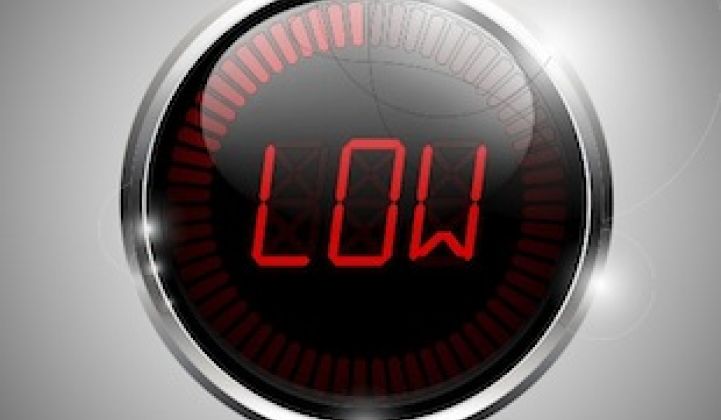In California, state regulators are getting ready to resolve a long-running conflict between the state’s big three investor-owned utilities, their customers, and companies that want to add batteries to solar PV systems.
And according to the statistics on how many solar-storage projects have been held up by this conflict, it couldn’t come too soon for the industry.
That’s one takeaway from a ruling (PDF) from California Public Utilities Commission President Michael Peevey, which has set in motion a process that could force utilities to back off a stance that’s holding up more than 300 solar-storage projects, adding up to 10 megawatts of capacity, that have been on backlog as of mid-2013.
That figure represents a first glimpse of the impact of the decision by the state’s big three investor-owned utilities, Southern California Edison, Pacific Gas & Electric, and San Diego Gas & Electric, to block solar-storage projects that seek to interconnect to the grid under the state’s net metering program.
Since this spring, those utilities have been requiring any net-metered solar power projects that include batteries to go through a lengthy and expensive process to prove their batteries aren’t feeding stored grid power back to the utility, while getting credited for delivering green, solar-generated electrons.
This has left some installers and customers unable to interconnect their solar-storage systems to the grid and start earning a return on their investment. It has also stalled many more projects that don’t pencil out economically under the extra costs that utilities are imposing, a fact that’s driven companies including SolarCity, Sunverge, Outback Power, and others that are installing energy storage alongside solar power systems to demand a change.
In the meantime, projects around the state are in limbo, awaiting a CPUC decision to put an end to the uncertainty. Here’s the data from Peevey’s October assigned commissioner ruling (ACR), which cites data from the state’s Self-Generation Incentive Program (SGIP):
“As of July 1, 2013, there were 667 active incentive applications in the SGIP queue for storage systems, totaling 33 MW of capacity. Of these, 319 applications, totaling 10 MW of capacity, are for storage paired with RPS-eligible generating facilities, primarily rooftop solar PV [emphasis added]. While the incentives provided by SGIP have supported increased storage deployment, the majority of these paired storage and generation applications have stalled during the interconnection process due to the lack of clear policy guidance on their eligibility for the NEM tariff schedule, which describes the NEM billing credits, exemptions from various charges, and metering arrangements.”
It’s important to note that this figure doesn’t include projects that have been proposed since July of this year. That could include a number of projects aimed at meeting California’s recently passed mandate requiring the state’s big three IOUs to add 1.3 gigawatts of energy storage to the grid by 2020.
It also likely doesn’t include a whole set of smaller-scale, household emergency backup battery-plus-solar projects, since they’re not designed to feed back power to the grid under SGIP rules. But projects like these have still been denied net metering status by utilities on the grounds that they could surreptitiously feed back “brown” electrons under the guise of solar power.
While Peevey’s ACR doesn’t overturn the utilities’ ability to deny net metering contracts to solar-storage projects, it does propose that the CPUC do just that in a future ruling. His proposal is to give qualifying storage devices “the same benefits available to renewable generating facilities under NEM tariffs until, at a minimum, December 31, 2015. Specifically, such storage devices would be exempt from standby charges, interconnection application and review fees and would not be required to pay for any distribution system upgrades triggered by the storage devices.”
Don Liddell, general counsel of the California Energy Storage Association (CESA), an industry group representing energy storage vendors, said in a Monday interview that the proceeding set in motion by Peevey’s ACR could yield a full commission proposal by mid-December. That’s expected to include more details on how the commission intends to balance concerns over how solar-storage projects affect utility net metering program integrity, distribution grid costs, and other issues.
It’s too early to know whether the CPUC will side with solar and energy storage advocates on this issue. But Peevey’s ACR lays out several points that seem to indicate that he’s not persuaded by the utility argument that storage-backed solar represents a threat to net metering, or that the additional steps utilities are requiring for these systems are reasonable.
Specifically, he notes that utilities are demanding that these systems install net generation output metering (NGOM) to differentiate battery output from net-metered solar output. But that’s more or less impossible for systems that combine solar and batteries behind a single inverter, which most simple solar-storage systems do, “because direct current meters meeting the NGOM requirements do not exist” -- a point that CESA also brings up in its November filing with the CPUC (PDF).
Instead of requiring a form of metering that doesn’t exist, Peevey’s ACR asks whether estimating the impacts of grid-stored power being fed back from a combined solar-storage system would be sufficient. As Liddell said, “The point there is that an estimate is good enough -- you don’t have to have revenue-quality metering data.”
California's big three utilities are busy installing and testing solar-storage systems of their own in pilot projects -- but they're also engaged in a fight with the solar industry around the costs and benefits of the state's net metering program. As the vanguard in solar-grid integration, what California does is likely to have a significant impact on the rest of the nation.



